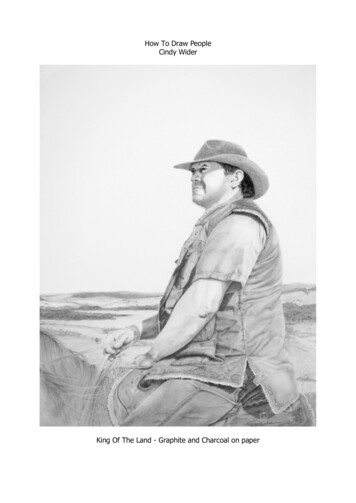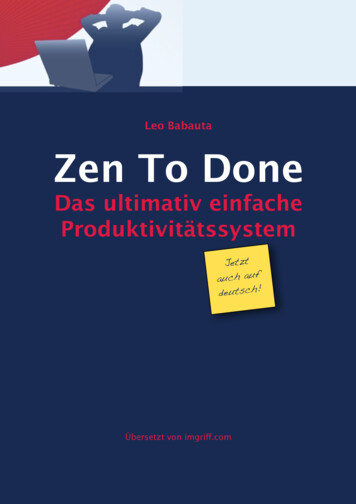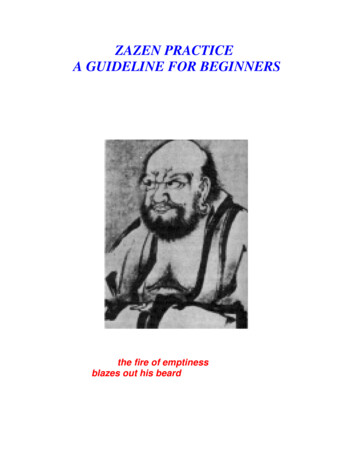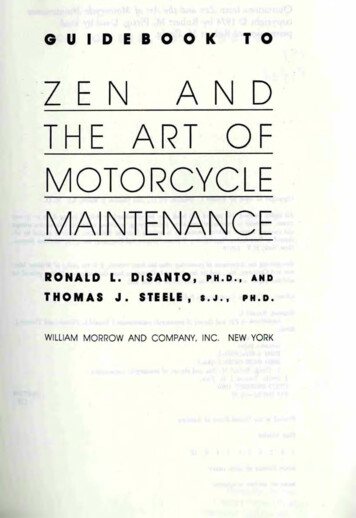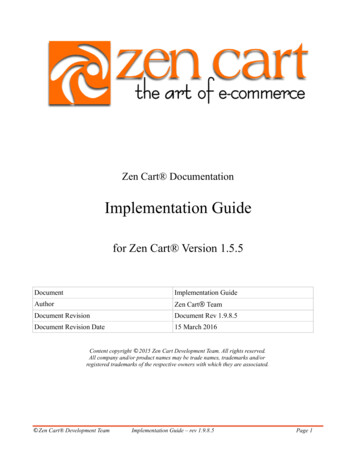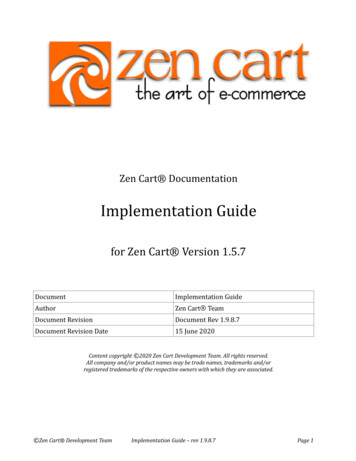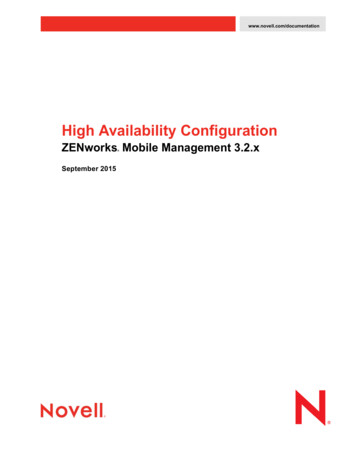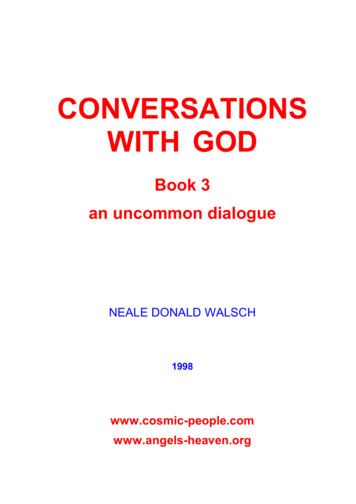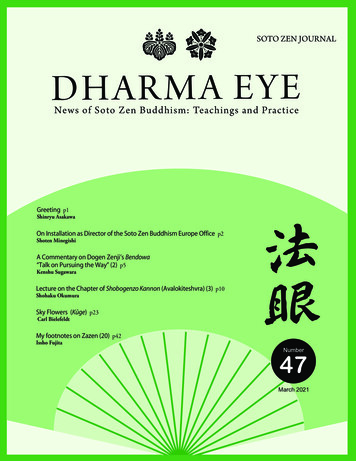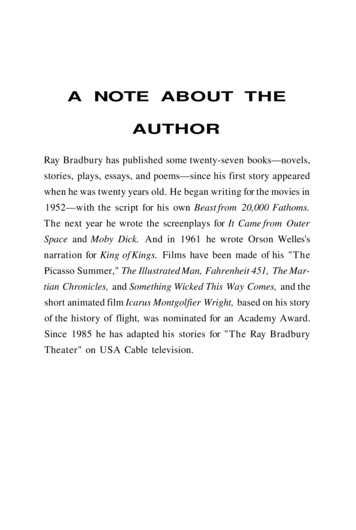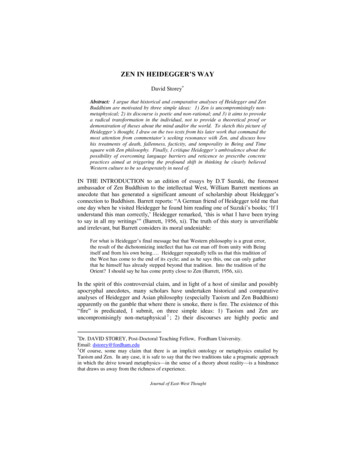
Transcription
ZEN IN HEIDEGGER’S WAYDavid Storey Abstract: I argue that historical and comparative analyses of Heidegger and ZenBuddhism are motivated by three simple ideas: 1) Zen is uncompromisingly nonmetaphysical; 2) its discourse is poetic and non-rational; and 3) it aims to provokea radical transformation in the individual, not to provide a theoretical proof ordemonstration of theses about the mind and/or the world. To sketch this picture ofHeidegger’s thought, I draw on the two texts from his later work that command themost attention from commentator’s seeking resonance with Zen, and discuss howhis treatments of death, fallenness, facticity, and temporality in Being and Timesquare with Zen philosophy. Finally, I critique Heidegger’s ambivalence about thepossibility of overcoming language barriers and reticence to prescribe concretepractices aimed at triggering the profound shift in thinking he clearly believedWestern culture to be so desperately in need of.IN THE INTRODUCTION to an edition of essays by D.T Suzuki, the foremostambassador of Zen Buddhism to the intellectual West, William Barrett mentions ananecdote that has generated a significant amount of scholarship about Heidegger’sconnection to Buddhism. Barrett reports: “A German friend of Heidegger told me thatone day when he visited Heidegger he found him reading one of Suzuki’s books; ‘If Iunderstand this man correctly,’ Heidegger remarked, ‘this is what I have been tryingto say in all my writings’” (Barrett, 1956, xi). The truth of this story is unverifiableand irrelevant, but Barrett considers its moral undeniable:For what is Heidegger’s final message but that Western philosophy is a great error,the result of the dichotomizing intellect that has cut man off from unity with Beingitself and from his own being . Heidegger repeatedly tells us that this tradition ofthe West has come to the end of its cycle; and as he says this, one can only gatherthat he himself has already stepped beyond that tradition. Into the tradition of theOrient? I should say he has come pretty close to Zen (Barrett, 1956, xii).In the spirit of this controversial claim, and in light of a host of similar and possiblyapocryphal anecdotes, many scholars have undertaken historical and comparativeanalyses of Heidegger and Asian philosophy (especially Taoism and Zen Buddhism)apparently on the gamble that where there is smoke, there is fire. The existence of this“fire” is predicated, I submit, on three simple ideas: 1) Taoism and Zen areuncompromisingly non-metaphysical 1 ; 2) their discourses are highly poetic and Dr. DAVID STOREY, Post-Doctoral Teaching Fellow, Fordham University.Email: dstorey@fordham.edu1Of course, some may claim that there is an implicit ontology or metaphysics entailed byTaoism and Zen. In any case, it is safe to say that the two traditions take a pragmatic approachin which the drive toward metaphysics—in the sense of a theory about reality—is a hindrancethat draws us away from the richness of experience.Journal of East-West Thought
114DAVID STOREYdecidedly non-rational; and 3) they aim to provoke a radical transformation in theindividual that forever alters his comportment toward himself, others, and the world,not to provide a theoretical proof or demonstration of theses about the mind and/or theworld. In this essay I will focus specifically on what role, if any, the Zen traditionplays in Heidegger’s early and later thought, with occasional references to Taoistthemes.The exploration of the nature of the Heidegger-Buddhism connection project has,roughly, taken at least one of two paths: influence 2 or resonance. While the hunt foran esoteric reading of any thinker is at best dangerous and at worst foolish, we areobligated to approach Heidegger armed with his own hermeneutical principle ofretrieve, which William Richardson describes thus: “to retrieve, which is to say whatan author did not say, could not say, but somehow made manifest” (Richardson, 2003,159). Dismissing the question of influence as moot and judging the evidence to beeither indirect, inconclusive, or non-existent, commentators such as Graham Parkeshave instead argued for a “pre-established harmony” between Heidegger’s thought asa whole and core tenets of Taoist and Buddhist philosophy. This claim presupposesthe accuracy of William Richardson’s thesis that Heidegger’s works constitute acoherent, unified whole — a thesis verified by Heidegger himself. 3 Fashioning Beingand Time as the last hurrah of metaphysics, the project whose residual metaphysicsHeidegger came to recant, the argument for pre-established harmony sees in theexistential analytic the fledgling formulations of a notion of selfhood and world that isquite alien to the Western tradition and rather congenial to Eastern thinking, a notionperhaps best described as nonduality. This residual metaphysics is repeatedthroughout Heidegger’s works along the lines of the ontological difference betweenBeing and beings, and constitutes an ambivalence over which scholars are stillsquabbling. This ambivalence, I hope to demonstrate, is demonstrated by Heidegger’sreticence to prescribe any concrete practices for triggering the radical shift in thinkinghe labored to galvanize. Heidegger appears to warn us that blithely attempting to stepoutside of and transcend one’s tradition, situation, and heritage, a prospect sotempting and even advantageous in today’s world, might very well land us in even2The search for direct influence is less often attempted, and with good reason. Few would likelyobject to the charge that Heidegger suffered from a chronic case of the so-called “anxiety ofinfluence.” If he was in fact influenced by Asian texts, he was even less bibliographicallyresponsible towards them as he was towards his Western intellectual forebears. Even the mostrigorous attempt to recover the “missing links” between Heidegger and the East — ReinhardMay’s well pleaded case for the “hidden sources” in the former’s work — fails to turn up anyevidence that would definitively indict the plaintiff. Despite a few off-hand remarks about LaoTzu and the Tao in his later works, the conversation with a Japanese inquirer included in On theWay to Language, his unfinished translation of the Tao Te Ching with Japanese Germanist PaulTsiao, and occasional mentions of Taoism and Buddhism in correspondence, Heidegger saysnothing about Asian texts and/or thinkers having a substantial affect on his thinking.3See Heidegger’s letter to Richardson in the Preface: “ even the initial steps of the Beingquestion in Being and Time thought is called upon to undergo a change whose movement corresponds to a reversal . the basic question of SZ is not in any sense abandoned by reason ofthe reversal” (xviii). Being and Time is hereafter abbreviated as SZ.Journal of East-West Thought
ZEN IN HEIDEGGER’S WAY115greater inauthentic peril than we were beforehand. However, by circumscribing thelimits of his tradition and designating which practices are off limits and which are not,Heidegger, I argue, ultimately reifies “the West.”In other words, neither the branches of the Western Enlightenment (Rationalismfrom Descartes to Hegel and Romanticism from Rousseau to Nietzsche) nor the rootsof Greek philosophy provided Heidegger with what he was looking for, and I suggestthat Asian philosophy in general and Zen in particular offer a corrective in the way ofpraxis to the very lopsidedness of theoria that Heidegger labored to amend. To sketchthis picture of Heidegger’s thought, I briefly point out texts from both his early andlater work that recommend comparison with key issues in Zen. First, I will draw onthe two texts from Heidegger’s later work that command the most attention fromcommentator’s seeking for Eastern resonance. Second, I discuss how Heidegger’streatment of death, fallenness, facticity, and temporality in SZ squares with Zenphilosophy. Finally, I submit a critique of Heidegger’s aforementioned ambivalenceabout the possibility of overcoming language barriers and reticence to prescribeconcrete practices aimed at triggering the profound shift in thinking he clearlybelieved Western culture to be so desperately in need of.I. Two DialoguesA. The Nature of Thinking: “Conversation on a Country Path about Thinking”4It is easy to plumb Heidegger’s later works and cherry pick passages that could havebeen plucked straight from the Tao Te Ching. The subtle, poetic flavor of this primarywork of Chinese Taoism easily lends itself to later Heidegger’s notion of “poeticdwelling.” Since both Taoism and Zen operate from a decidedly non-metaphysicalcomportment, and prefer poetic and paradoxical forms of expression that intentionallythwart logical analysis and discursive reasoning, it is easy to see why many scholarshave been struck by their similarity to later Heidegger’s experiments with language.Indeed, Otto Pöggeler, one of Heidegger’s most able and respected Germancommentators, charges that the Tao Te Ching played a crucial role in the developmentof Heidegger’s later thought (Parkes, 1987).Be that as it may (or may not), the stylistic similarities between two thinkers ortwo philosophical systems can all too easily seduce us into passing over the real andirrevocable differences that force them apart. This is especially dangerous inHeidegger’s case, since the recurrent character of his later attempts at reformulatingthe question of Being are aimed precisely at unseating the very notion of there being amaster narrative, a complete system, a coherent body of doctrine. As David Loyobserves: “It is not possible to discuss Heidegger’s system because, like Nagarjuna,he has none. For Heidegger thinking is not a means to gain knowledge but both thepath and the destination” (Loy, 1988, 164).5 All is always already way, and that seems4Hereafter abbreviated as CP.David Loy, Nonduality, 164. I will return to Loy’s comparison of Nagarjuna’s andHeidegger’s methodology in section 1B.5Journal of East-West Thought
116DAVID STOREYto be all that we are allowed to say about the matter — there can be no calculation ormeaningful organization, sequence, or pattern to the various way-stations, moments,or thoughts that occur along the way. Reflecting on one of his own “moments” —Being and Time itself — Heidegger remarked: “I have forsaken an earlier position,not to exchange it for another, but because even the former position was only a pauseon the way. What lasts in thinking is the way” (Dialogue, 1971, 12). Compare D.T.Suzuki:All Zen’s outward manifestations or demonstrations must never be regarded asfinal. They just indicate the way where to look for facts. Therefore theseindicators are important, we cannot do well without them. But once caught in them,which are like entangling meshes, we are doomed; for Zen can never becomprehended (Barrett, 1956, 21).The Zen analogue to Heidegger’s notion of “preoccupation with beings” (CP) or“entanglement” (SZ) is tanha, popularly translated somewhat misleadingly as“desire.” A more proper rendering would be “attachment” or “clinging” tophenomena. To seize upon the flux and freeze Being/Tao in its tracks, to attempt tomaster, fix, or cling to it with language or logic, is, Heidegger believes, the mistakeand miscalculation of Western metaphysics. Being just sort of “does its own thing,”and we are inexorably caught up in its sway. Our best bet is to release ourselves tothis Being-process, not in the sense of demurring or “giving way” to it, but offering orourselves up to it as servants. Two of later Heidegger’s works stand out due to theirformal character: the CP and the DL. The dialogue is an ideal site for interrogatingand pinning down the core of Heidegger’s later thought, and thus apprehending whatkinship it may have with Taoist and Zen thought, because it is flexible enough tocontain both rational and poetic discourse. That is, it suffers neither from theconstraints of monologic — the metaphysics of subjectivity (inaugurated by Descartesand repeated by Sartre) laced within SZ that Heidegger eventually came to recant —nor from the vagary of poetic saying, yet provides a space in which both can havetheir say. Peter Kreeft usefully qualifies this as “a highly disciplined, exacting kind ofpoetry,” a kind of saying that, Heidegger thinks, is more rigorous than and indeedmakes possible rational discourse itself (Kreeft, 1971, 521).6 In this section, I draw onthese two dialogues in order to show the congruence of Heidegger’s later thoughtwith some basic Zen tenets.The CP is held between a scientist, a scholar, and a teacher. These three figuresspeak, respectively, for three basic comportments toward or from Being. The first is6Peter Kreeft, “Zen in Heidegger’s Gelassenheit,” 542. Rational discourse in the form ofmathematics or logic may very well excel at precision, exactness, and clarity, yet these qualitiesobtain validity only within their proper domains, that is, their validity claims are regionspecific. In “What Is Metaphysics?” (hereafter WIM?) Heidegger writes: “No particular wayof treating objects of inquiry dominates the others. Mathematical knowledge is no morerigorous than philosophical-historical knowledge. It merely has the character of ‘exactness,’which does not coincide with rigor.” The rub is that Heidegger’s way of thinking is not a“particular way of treating objects”; nor is Zen (Basic Writings, 94) .Journal of East-West Thought
ZEN IN HEIDEGGER’S WAY117the Dasein who is blind to the phenomenon of the world. This is the objectifyingstance criticized in SZ, the monological Scientist curious about and transfixed byphenomena, asleep to his own unheeded intentional comportments to the world. TheScientist disenchants the world by dissecting it with analytical reason and foisting hisown conceptual straightjackets on things with a view to seizing their “essence,” andthus takes things, literally, only on his own terms. In Division II of SZ thiscomportment is described as “making-present.”The second comportment is the Scholar, who represents Dasein as awakening toand reflecting on the existential-ontological structures that govern its engagementwith the world and, by rendering itself transparent to those structures, seizing itself inits freedom unto death, toward its ownmost end and ultimate possibility. This is the“authentic” comportment championed in Division II, which enacts a non-conceptualway of thinking and assumes a place in and towards Being, yet draws up short at thetranscendental horizon of temporality. The “way in which ecstatic temporalitytemporalizes,” what makes the projection of Dasein’s existence possible, indeed,whether and how “time manifests itself as the horizon of Being” is what calls forinterpretation (Heidegger, 1962, 488). Yet interpretation, by definition, cannotoverstep that very horizon, because meaning and sense can only be made andregistered on this “side” of the temporal “border.” The project to think toward beingthus fails, and Dasein is cast back upon itself in its having-been, and this calls for anew approach. This is the state of the Scholar, who has pushed rational discourse toits limit, and is left wanting and waiting for some clue as to how to proceed on theway towards Being.The third figure, that of the Teacher, embodies a disposition unrepresented yetcertainly hinted at in SZ: Gelassenheit. Whereas the prior two positions weresubjectivistic insofar as they thought toward Being, the Teacher endeavors to thinkfrom Being, to keep silent about and wait for the temporalizing of ecstatic temporality— here called the “regioning” of “that-which-regions” — but not in such a way as tobe frustrated by the lack of an answer, to be stymied about failing to find the words orconcepts with which to interpret or locate the meaning of Being. The Teacher’sdiscourse is thus properly characterized as trans-logical.Gelassenheit is not “giving up”; still less it is “cracking the code” of Being. Asthe translators note, “[Gelassenheit] is thinking which allows content to emergewithin awareness, thinking which is open to content meditative thinking begins withan awareness of the field within which these objects are, an awareness of the horizonrather than of those objects of ordinary understanding” (Heidegger, 1966, 24). Morespecifically, Heidegger is claiming that all thinking necessarily begins this way, andso a thinking that explicitly acknowledges this fact enjoys a more primordialrelationship with Being, and therefore with thought itself. This necessity is neitherlogical nor causal, nor it is contained in the nature of a substance called “humanbeing.” Indeed, Heidegger makes it clear at the start that “the question concerningman’s nature is not a question about man” (Ibid., 1966, 58). To go against this grainand attempt to calculate, plan, plot, represent, or frame Being in any totalizing manneris thus at once a perversion of both Being and thinking. This is surely why, as PeterJournal of East-West Thought
118DAVID STOREYKreeft points out, “Heidegger uses a word designating what Being does (“regions”)rather than what it is” (Kreeft, 1971, 543).To be released toward things is to wait upon Being. 7 “Waiting” itself is definedtwo ways in the CP. These two definitions are tightly bound to the two conceptions oftime contrasted in SZ. The first is the ordinary practice of “waiting for” things, events,occasions, etc. This waiting toward things is grounded in a making present whichneutralizes the future qua possibility by interpreting it merely within the narrow scopeof the desires, goals, and objectives of the present, following the rigid dictates of theschedule, the calendar, or the scheme. This fixing of the future is at once theconstriction of the present, robbing the present of its possibility and significance byinterpreting the “now” as a solipsized point in a succession of nows that is separatedfrom the object that Dasein awaits. The ecstatic structures are thus dissociated and/orrepressed, Dasein disperses itself among and invests itself in its worldlyentanglements, and it fails to hold itself together precisely by rushing around trying tofix and control things; Dasein is ready for nothing because it is trying to be ready foreverything, foreclosing its possibilities by trying to plan for all of them. Thestructures of involvement delineated in Division I of SZ — the “for-the-sake-ofwhich,” the “in-order-to”, etc. — correlate roughly with this notion of “waiting for.”The second definition of waiting, “waiting upon,” is practiced without theexpectation of the fulfillment of an intention. Indeed, it is characterized by the lack ofany such intention. This cessation of intentional relations is indicative of an erosionof any notion of a “subject” with will, desire, self-sameness, and a shift in the locus ofidentity and the seat of action towards Being and away from Dasein. As the Scholarremarks: “the relation between that-which-regions [i.e., Being] and releasement, if itcan still be considered a relation, can be thought of neither as ontic nor asontological,” only, adds the teacher, “as regioning” (Heidegger, 1966, 76). 8 There isthus a shift in the language Heidegger uses to describe the matter of the conversation:not the “meaning of Being” (SZ) but the “nature of thinking.” 9 To wait upon Beingthus connotes service. The active connotations of freedom, authentication,individuation, and seizing one’s destiny that color SZ give way to more passivenotions of serving, waiting, allowing, etc. Put differently: there is a shift in emphasisfrom existentiality to facticity, from man’s projecting to Being’s throwing.Yet those so released are not merely “slaves” of Being. The Scientist observesthat releasement “is in no way a matter of weakly allowing things to slide and drift7The translator makes a qualification: “Waiting upon does not evoke Being, even though thesuggestion is that if anything responded to such waiting, it would be Being” (Conversation, 23).The point here is that Heidegger does not mean to say that waiting upon automaticallyestablishes some direct pipeline to Being—Being here denotes No-thing, that is, none of theobjects that arise, linger within, and pass out of the clearing that is Dasein, none of the thingsthat significantly register as things for and within Dasein’s concernful circumspection.8CP, 76, my italics. I wish to emphasize how Heidegger here problematizes the language of“relation” between Dasein and Being, because the latter two notions are destabilized, theirduality called into question.9The nature of thinking, in turn, gives way to the nature of language. Note the shift, or drift, ofthe object of inquiry: from Being to Thought to Language. See the discussion of the DL below.Journal of East-West Thought
ZEN IN HEIDEGGER’S WAY119along,” and “lies beyond the distinction between activity and passivity” (Heidegger,1966, 61). Heidegger is not condoning an ascetic denial of world and will along thelines of Schopenhauer’s pessimism; releasement is most definitely not a renunciationthat “floats in the realm of unreality and nothingness” (Heidegger, 1966, 80).Similarly, Suzuki dismissed the popular view which identifies the philosophy ofSchopenhauer with Buddhism. According to this view, the Buddha is supposed tohave taught the negation of the will to live, which was insisted upon by the Germanpessimist, but nothing is further from the correct understanding of Buddhism than thisnegativism. The Buddha did not consider the will blind, irrational, and therefore to bedenied; what he really denies is the notion of ego-entity due to Ignorance, from whichnotion come craving, attachment to things impermanent, and the giving way toegoistic impulses (Barrett, 1956, 157).Anticipatory resoluteness still has a place within releasement: “one needs tounderstand ‘resolve’ as it is understood in Being and Time: as the opening of manparticularly undertaken by him for openness which we think of as that-whichregions” (Heidegger, 1966, 81). Again, we are not permitted to think of openness assomething “out there” ontologically separate from Dasein, since we have been toldexplicitly that terms such as ontic, ontological, relation, and thing either no longerapply in the former sense, or no longer apply, period. The type of comportmentHeidegger champions is thus active in so far as it calls for an adjustment in Dasein’sattunement, but not in the sense of operating upon any object in the world-horizonwith a view toward engineering a different and desired state of affairs. Heidegger thusrefers to it as a “trace of willing”; it is passive insofar as it holds itself steadfast inlight of the knowledge that none of its actions can directly “get through” to Being and,more importantly, it ceases to resent or repress this inescapable fact (Heidegger, 1966,51).10 As Peter Kreeft points out, a higher acting is concealed in releasement than isfound in all the actions within the world . Not only do we become supremely(though effortlessly) active as a result of releasement, but we must exercise the moststrenuous activity in order to reach its inactivity, much as the Zen monk must beat hishead against the stone wall of his koan with all his energy until his head splits and hisbrains spill out into the universe where they belong (Kreeft, 1971, 553).1110Compare this notion of a “trace of willing” to a well-known passage from Dogen’s Genjokoan: “To study the Buddha way is to study the self. To study the self is to forget the self. Toforget the self is to be actualized by the myriad things. When actualized by myriad things, yourbody and mind as well as the bodies and minds of others drop away. No trace of realizationremains, and this no-trace continues endlessly.” Quoted by Loy in A Buddhist History of theWest, 7.11Kreeft, 533. Below I will return to Suzuki’s admonition that we must not neglect theuncompromisingly masculine, Erotic, transcending aspect of this affair, and relate to earlyHeidegger’s phallic language of freedom, resolve, and authenticity, language which really isjust jargon if not supported by a set of practices that bring forth and habituate the primordialexperience that is repressed and forgotten by the They-self. Zen counsel’s the annihilation ofthe They-self, yet early Heidegger deems this impossible. Why? Because, as he later noted,his existential structuralism was too static and unyielding.Journal of East-West Thought
120DAVID STOREYHeidegger is clear on this point: “Releasement toward things and openness to themystery never happen of themselves. They do not befall us accidentally. Both flourishonly through persistent, courageous thinking” (Heidegger, 1966, 56). On a similarnote, Joan Stambaugh remarks that “Heidegger’s idea of Austrag (perdurance,sustained endurance) bears a striking resemblance to Dogen’s ‘sustained exertion,’the ‘highest form of exertion, which goes on unceasingly in cycles from the firstdawning of religious truth, through the test of discipline and practice, toenlightenment and Nirvana.’ These two related ideas both implicitly have to do withtime” (Stambaugh, 1987, 285). American Zen roshi Richard Baker once remarkedthat satori, or enlightenment, is an accident, and that meditation makes one accidentprone. Meditation (zazen) is the preparation, the work that renders the self receptiveto satori but does not directly trigger it. Speaking about the notion of “waiting upon,”Kreeft notes: “Like a Zen master, Heidegger does not tell us what to do, only what notto do. And in response to the natural question complaining of the resultingdisorientation, he intensifies instead of relieving the disorientation, again like a Zenmaster” (Kreeft, 1971, 535). In a crucial but qualified sense, there is a process ofspiritual “development” in Zen, but it not a teleological process. Zen practice is notthe cultivation of positive qualities or characteristics; it is not about conditioning, butabout deconditioning — hence, what not to do. The Zen analogue of releasement is“non-attachment,” and its purpose is not to crush and stifle the thought-process, but tolet all phenomena—sensory perceptions, emotional tensions, concepts, etc. — simplygo, to liquidate one’s cognitive assets, to exhaust the discursive mind, and graduallycease to identify with any bodily (gross) or mental (subtle) “substance”, until thebodymind itself is “dropped.”Before leaving the CP, it is important to mention the discussion of ego,experiment, and the Being-process contained therein. Heidegger’s end of philosophyis really just the end of philosophy as the mirror of nature,12 the end of a conception12Two passages from WIM powerfully drive this idea home: “If the power of the intellect in thefield of inquiry into the nothing and into Being is thus shattered, then the destiny of the reign of‘logic’ in philosophy is thereby decided. The idea of ‘logic’ itself disintegrates in theturbulence of a more original questioning.” (105) Compare Suzuki: “[Zen] does not challengelogic, it simply walks its own path of facts, leaving all the rest to their own fates. It is onlywhen logic neglecting its proper functions tries to step into the track of Zen [or, for Heidegger,tries to soberly and seriously dismiss the nothing] that it loudly proclaims its principles andforcibly drives out the intruder.” (21) “We can of course think the whole of beings in an ‘idea,’then negate what we have imagined in our thought, thus ‘think’ it negated.” In this way do weattain the formal concept of the imagined nothing but never the nothing itself , the objectionsof the intellect would call a halt to our search, whose legitimacy, however, can be demonstratedonly on the basis of a fundamental experience of the nothing” (99, my italics). I want toemphasize that Zen, as Suzuki indicates, has a decidedly more “laissez-faire” attitude towardreason; it is only when reason purports to extend its validity claims beyond its proper spherethat problems ensue. Heidegger’s antagonism toward calculative thinking, I am claiming here,is somewhat exaggerated and fails to recognize the positive aspects of reason, aspects which, infact, provide him with the space to sight his quarry.Journal of East-West Thought
ZEN IN HEIDEGGER’S WAY121of science that regarded itself as unconditioned but was actually, according toHeidegger, only a historical emergence:Scientist: “When I decided in favor of the methodological type of analysis in thephysical sciences, you said that this way of looking at it was historical . Now I seewhat was meant. The program of mathematics and the experiment are grounded inthe relation of man as ego to the thing as object.” Teacher: “They even constitute thisrelation in part and unfold its historical character . The historical consists in thatwhich-regions . It rests in what, coming to pass in man, regions him into his nature”(Heidegger, 1966, 79).Thus the “ego” and its project of measuring, classifying, and discovering the worldemerged over time, yet it tries to burn its birth certificate and cover up its contingencyby grounding itself in some transcendent Other.Two passages from WIM? powerfully capture the relationship between reasonand the nothing, the egoic and the trans-egoic, the logical and the trans-logical: “Ifthe power of the intellect in the field of inquiry into the nothing and into Being is thusshattered, then the destiny of the reign of ‘logic’ in philosophy is thereby decided.The idea of ‘logic’ itself disintegrates in the turbulence of a more originalquestioning” (Heidegger, 1977, 105). Compare Suzuki: “[Zen] does not challengelogic, it simply walks its own path of facts, leaving all the rest to their own fates. It isonly when logic neglecting its proper functions tries to step into the track of Zen [or,for Heidegger, tries to soberly and seriously dismiss the nothing] that it loudlyproclaims its principles and forcibly drives out the intruder” (Barrett, 1956, 21).Heidegger:We can of course think the whole of beings in an
on the way. What lasts in thinking is the way” (Dialogue, 1971, 12). Compare D.T. Suzuki: All Zen’s outward manifestations or demonstrations must never be regarded as final. They just indicate the way where to look for facts. Therefore these indicators are important,
